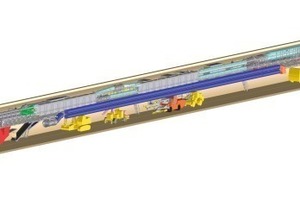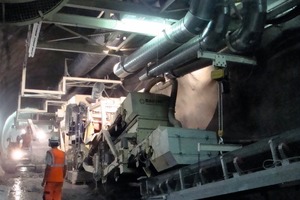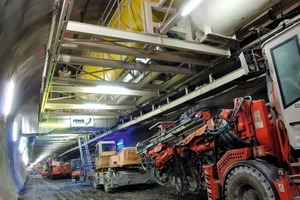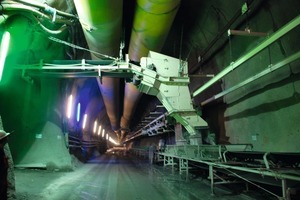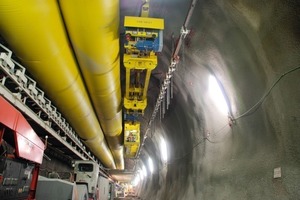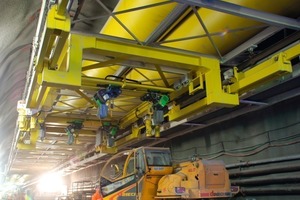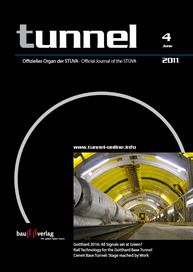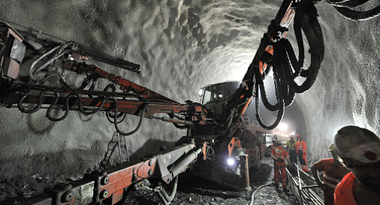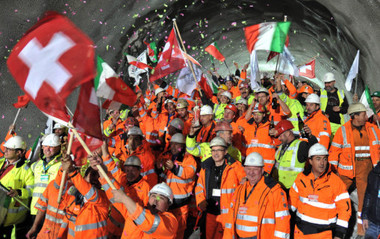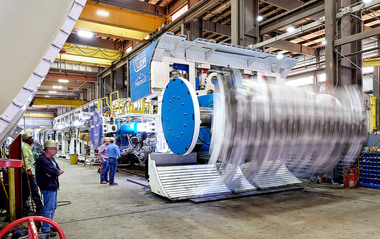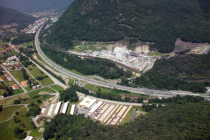Substantial Mechanization for Conventional Main Headings at the Ceneri Base Tunnel
The main headings of the Ceneri Base Tunnel are conventionally carried out starting from the intermediate access Sigirino. The owner and the joint venture have mutually decided to use a highly mechanized drill and blast heading method. The applied installations lead to rationalized work flows and, therefore, to significant productivity increase. Moreover, all participants will benefit from more human work places as well as increased work safety.
The Ceneri Base Tunnel
The Ceneri Base Tunnel is the logical continuation of the Gotthard Base Tunnel towards the South, and it creates a continuous flat rail link through the Alps with the New Gotthard Rail Link. As a result of the flat and straight route, freight trains with up to 4,000 t trailing load can be driven non-stop through Switzerland at up to 160 km/h, and without mid-train or pushing engine. The Ceneri Base Tunnel will enable travel time reduction of passenger traffic and secure optimal connections for passengers in Zurich and Milan in the future [1].
Similar to the Gotthard Base Tunnel, the Ceneri Base Tunnel system consists of 2 single track tubes which lead from the Northern portal Vigana/Camorino to the Southern portal Vezia, and which are connected with cross passages. Besides some shorter, conventional headings at the 2 portals, the main headings are carried out from an underground cavern (Caverna Operativa), which was accessed from Sigirino through a 2,3 km long access tunnel with 5 % incline. Taking into consideration the different rock formations which had to be traversed, the Consorzio Condotte Cossi which was awarded the main section 852, had decided for drill and blast heading exclusively, even though a TBM-heading on 4 km length each would also have been possible, according to the tender.
For this purpose, the owner Alptransit Gotthard AG and the Consorzio Condotte Cossi aimed for highly mechanized drill and blast heading. They gave Rowa Tunnelling Logistics AG the order to develop, produce, supply, assemble and start up 4 identical heading installations.
Draft of Heading Installations
When planning the heading installations in close cooperation with the customer, Rowa was able to make use of experience and valuable insight gained from other heading mechanization projects in tunnelling construction. In this context, experiences made with suspended work- and heading-platforms from the Mitholz section of the Lötschberg Base Tunnel, as well as from the Sedrun and Amsteg sections of the Gotthard Base Tunnel, could be used for the heading installations of the Ceneri Base Tunnel [2].
Each installation basically consists of ventilation platform, heading platform, invert platform, crusher, conveyors and monorail (single track suspension rail) (Fig. 1).
Blowing and suction ventilation provides fast access to rock face and health protection
Optimal ventilation and cooling are important measures to guarantee health protection and work safety in tunnel headings.
Fresh air is sucked in at the portal of the Sigirino exploration tunnel, and then blown from the Caverna Operativa via airducts to the rear of the respective heading platforms. Here, the fresh air is picked up on 2 stages with 2 ventilators each (max. 2 x 16 m3/s overall performance) and transferred to the rock face by 2 airducts of 900 mm diameter.
For this project, Rowa Tunnelling Logistics AG constructed for the first time a ventilation platform which can be moved independently from the heading platform. It carries the spiral airducts of the blowing ventilation and can be telescoped 40 m, up to approx. 30 m behind the rock face (Fig. 2). Thereby, supply of fresh air can be optimized and blasting fumes flushed efficiently. The latter are vacuumed off in front of the heading platform with a sucking ventilator (max. 28 m3/s overall performance), transferred at the rear of the heading platform and from there with a second ventilator through an exhaust airduct of 1,800 mm diameter to the access tunnel. Therefore, the blast fumes are not passing through the heading platform and the invert construction site behind the heading. Before blasting, the ventilation platform is retracted next to the crusher and, therefore, out of danger. All ventilators can be centrally monitored; the ventilation platform can be extended via friction wheel drive at the touch of a button in the safety container area after the blasting. The tunnel constructors are, therefore, rarely exposed to unhealthy blasting fumes, while the ventilation platform enables a fast clearing of the rock face for rubble removal and rock support work.
Geothermal heat is growing with increasing depth of the construction sites; high performance construction equipment produces additional waste heat. In case that ventilation at the Ceneri Base Tunnel (overlays of up to 800 m) would have to be supplemented by cooling systems to comply with SUVA’s climate limit, the necessary space for them has already been planned on the heading platforms.
Simultaneous trailing of complete infrastructure and sufficient room for construction equipment
All infrastructure installations can be placed onto the 135 m long heading platform. They are, in particular, a dedusting unit with 1,200 m3/s performance, the ventilators for blowing and suction ventilation, an air compressor, a water pressure booster system, an emergency generator (200 kVA performance), a transformer for conversion of medium voltage (16,000 V) to 380 V, respectively 220 V, as well as a high voltage cable drum. A container for the heading management, one storage container each for electricians and mechanics, lifting devices, airduct cassettes for blowing and suction ventilation as well as a maintenance area for the monorail, are also placed onto the platform.
Precisely like the ventilation platform, the invert platform and the conveyors, the heading platform moves on suspension tracks suspended from the vault with chains and special adaptors to friction rockbolts of the Bellex 120 Forte type.
Three stepping devices with appropriate hydraulics and control are placed on the heading platform, 3 additional ones are placed alongside the towing conveyor in such a way that the entire heading installation can be pulled forward at the touch of a button and according to the heading progress.
Below the heading platform on the invert, the tunnel constructors have a second working level and free floor space for working, maneuvering and parking at their disposal (Fig. 3). Working safety has been increased substantially thanks to clearly arranged space conditions, the rationalization of work flows and the generous illumination.
Jaw crusher, towing conveyor and transfer conveyor for muck removal logistics
Rowa Tunnelling Logistics AG and their client Consorzio Condotte Cossi have implemented a logistics system which allows for direct material transport from the rock face to the portal of the access tunnel at the touch of a button – and, taking into account the subcontractor for material handling – all the way to the muck disposal site.
The excavated material is transported after every blast with a wheel loader from the rock face over a distance of 50 to 70 m to the mobile crawler type crusher with primary screen, screen and metal separator.
The 630 m long and 800 mm wide towing conveyor for removal of the excavation material crushed by the jaw crusher is suspended below the heading platform. The ascending area behind the crusher can be lifted for displacement of the suspension platform.
The towing conveyor drops the excavation muck onto a transfer conveyor which is towed every 330 m, simultaneously with the extension of the continuous conveyor. Cross conveyors are transporting the excavation muck of the Eastern tubes through cross passages to the continuous conveyors in the Western tubes (Fig. 4).
A monorail guarantees direct supply of the heading
Supply of the heading with rock support material, shotcrete in mixing containers, wear and tear material as well as explosives is guaranteed by the monorail, which bridges over the invert construction site and the heading installation.
The monorail moves on an additional suspension track suspended with chains and eye bolts from the vault on friction rockbolts of the Bellex 240 Forte Mono type. Bracings absorb induced acceleration and deceleration forces.
Materials are delivered by truck through the completed tunnel invert in dedicated receptacles. The monorail (load capacity 15 t, Fig. 5) carries these loads directly to the heading with a maximum speed of 1.8 m/s. Interim stations along the 400 m long rail section can equally be supplied.
Tunnel invert continuously being constructed along with the heading
Simultaneously with the heading operation, a self-moving formwork is fitting the entire width of the invert. The in situ concrete is supplied with a truck and transported to the installation site by a 15 t heavy duty crane (Fig. 6) suspended from the invert platform. Heavy replacement parts for the construction equipment can also be transported across the invert construction site with the travelling crane.
The 66 m long invert platform can be moved with a total of 8 friction drives. The relative traverse path to the heading platform amounts to approx. 50 m, thereby considerably reducing the interdependencies between the 2 construction sites.
First experiences confirm the decision for this system
Out of the altogether approx. 40 km of single track tubes, cross passages and tunnels which have to be excavated for the Ceneri Base Tunnel, almost one third was completed at copy deadline. Three of the 4 heading installations delivered by Rowa Tunnelling Logistics AG were already operational and their worth confirmed. The fourth installation is presently being assembled in the North-West tunnel.
“The high mechanization of conventional heading initially requires a more substantial investment from the contractor, and profitability can only be achieved by increased heading performances” explains Andrea Ottolin, project manager of Consorzio Condotte Cossi. “Our miners were quickly able to adapt to the increased demands of high mechanization. In spite of existing geotechnical difficulties, we feel that we made the right decision when choosing this system. In the course of the present learning process, we will soon be able to increase productivity considerably. We are proud to be in a position to set new standards for mechanized drill and blast heading with our installations”, continues Ottolin.
Also the heading area’s health and work hygiene conditions are improved by mechanized drill and blast heading. The new ventilation platform was particularly well received by the miners: “The fast flushing of blast fumes within minutes after each blast and the regulated amount of fresh air make work easier”, was mentioned by various miners.
With these illustrated installations, Rowa Tunnelling Logistics AG is pursuing the continuous development of mechanization in tunnelling construction. It will lead to a rationalization of work flows and, therefore, to significant productivity increase. And last but not least, all persons involved will profit from more human work places and increased work safety.

